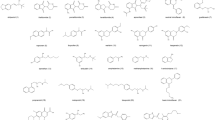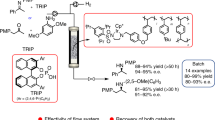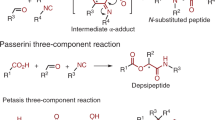Abstract
We describe an effective and simple protocol that uses click chemistry to attach native β-cyclodextrin (β-CD) to silica particles, resulting in a chiral stationary phase (CCNCSP) that can be used for the enantioseparation of chiral drugs by high-performance liquid chromatography (HPLC). Starting from β-CD, the CCNCSP is prepared in several steps: (i) reaction of β-CD with 1-(p-toluenesulfonyl)-imidazole to afford mono-6-toluenesulfonyl-β-CD; (ii) azidolysis of mono-6-toluenesulfonyl-β-CD in dimethylformamide to give mono-6-azido-β-CD (N3-CD); (iii) reaction of cuprous iodide with triphenylphosphine to form an organic soluble catalyst CuI(PPh3); (iv) preparation of alkynyl-modified silica particles; and (v) click chemistry immobilization of N3-CD onto alkynyl-modified silica to afford the desired chiral stationary phase. Synthesis of the stationary phase and column packing takes ∼1 week.
This is a preview of subscription content, access via your institution
Access options
Subscribe to this journal
Receive 12 print issues and online access
$259.00 per year
only $21.58 per issue
Buy this article
- Purchase on Springer Link
- Instant access to full article PDF
Prices may be subject to local taxes which are calculated during checkout





Similar content being viewed by others
References
Tang, W.H. & Ng, S.C. Synthesis of cationic single-isomer cyclodextrins for the chiral separation of amino acids and anionic pharmaceuticals. Nat. Protoc. 2, 3195–3199 (2007).
Tang, W.H. & Ng, S.C. Facile synthesis of mono-6-amino-6-deoxy-α-, β-, γ-cyclodextrin hydrochlorides for molecular recognition, chiral separation and drug delivery. Nat. Protoc. 3, 691–697 (2008).
Armstrong, D.W., Ward, T.J., Armstrong, R.D. & Beesley, T.E. Separation of drug stereoisomers by the formation of β-cyclodextrin inclusion complexes. Science 232, 1132–1135 (1986).
Easton, C.J. & Lincoln, S.F. Chiral discrimination by modified cyclodextrins. Chem. Soc. Rev. 25, 163–170 (1996).
Xiao, Y., Ong, T.T., Tan, T.T.Y. & Ng, S.C. Synthesis and application of a novel single-isomer mono-6-deoxy-6-(3R,4R-dihydroxypyrrolidine)-beta-cyclodextrin chloride as a chiral selector in capillary electrophoresis. J. Chromatogr. A 1216, 994–999 (2009).
Wang, Y., Ong, T.T., Li, L.S., Tan, T.T.Y . & Ng, S.C. Enantioseparation of novel 'click' chemistry derived native β-cyclodextrin chiral stationary phase for high-performance liquid chromatography. J. Chromatogr. A 1216, 2388–2393 (2009).
Wang, Y., Young, D.J., Tan, T.T.Y . & Ng, S.C. 'Click' immobilized perphenylcarbamated and permethylated cyclodextrin stationary phases for chiral high-performance liquid chromatography. J. Chromatogr. A 1217, 5103–5108 (2010).
Muderawan, I.W., Ong, T.T. & Ng, S.C. Urea bonded cyclodextrin derivatives onto silica for chiral HPLC. J. Sep. Sci. 29, 1849–1871 (2006).
Pirkle, W.H. & Welch, C.J. Use of simultaneous face to face and face to edge π-π interactions to facilitate chiral recognition. Tetrahedron: Asymmetry 5, 777–780 (1994).
Zhang, T., Nguyen, D. & Franco, P. Enantiomer resolution screening strategy using multiple immobilised polysaccharide-based chiral stationary phases. J. Chromatogr. A 1191, 214–222 (2008).
Zhang, T. et al. Solvent versatility of immobilized 3,5-dimethylphenylcarbamate of amylose in enantiomeric separations by HPLC. J. Chromatogr. A 1075, 65–75 (2005).
Armstrong, D.W. et al. Macrocyclic antibiotics as a new class of chiral selectors for liquid chromatography. Anal. Chem. 66, 1473–1484 (1994).
Cho, H.S., Choi, H.J. & Hyun, M.H. Preparation of a new crown ether-based chiral stationary phase containing thioester linkage for the liquid chromatographic separation of enantiomers. J. Chromatogr. A 1216, 7446–7449 (2009).
Lloyd, D.K., Li, S. & Ryan, P. Protein chiral selectors in free-solution capillary electrophoresis and packed-capillary electrochromatography. J. Chromatogr. A 694, 285–296 (1995).
Wisbuba, D. & Schurig, V. Enantiomer separation by pressure-supported electrochromatography using capillaries packed with Chirasil-Dex polymer-coated silica. Electrophoresis 20, 2779–2785 (1999).
Fujimura, K., Ueda, T. & Ando, T. Retention behavior of some aromatic compounds on chemically bonded cyclodextrin silica stationary phase in liquid chromatography. Anal. Chem. 55, 446–450 (1983).
Fujimura, K., Suzuki, S., Hayashi, K. & Masuda, S. Retention behavior and chiral recognition mechanism of several cyclodextrin-bonded stationary phases for dansyl amino acids. Anal. Chem. 62, 2198–2205 (1990).
Kawaguchi, Y., Tanaka, M., Nakae, M., Funaso, K. & Shone, T. Chemically bonded cyclodextrin stationary phases for liquid chromatographic separation of aromatic compounds. Anal. Chem. 55, 1852–1857 (1983).
Han, X.X., Yao, T.L., Liu, Y., Larock, R.C. & Armstrong, D.W. Separation of chiral furan derivatives by liquid chromatography using cyclodextrin-based chiral stationary phases. J. Chromatogr. A 1063, 111–120 (2005).
Wang, C.L., Jiang, C.X. & Armstrong, D.W. Considerations on HILIC and polar organic solvent-based separations: use of cyclodextrin and macrocyclic glycopetide stationary phases. J. Sep. Sci. 31, 1980–1990 (2008).
Ng, S.C., Chen, L., Zhang, L.F. & Ching, C.B. Facile preparative HPLC enantioseparation of racemic drugs using chiral stationary phases based on mono-6-azido-6-deoxy-perphenylcarbamoylated β-cyclodextrinimmobilized on silica gel. Tetrahedron Lett. 43, 677–681 (2002).
Lai, X.H., Bai, Z.W., Ng, S.C. & Ching, C.B. Preparation and enantioseparation characteristics of two chiral stationary phases based on mono(6A-azido-6A-deoxy)-perphenylcarbamoylated α- and β-cyclodextrin. Chirality 16, 592–597 (2004).
Muderawan, I.W., Ong, T.T. & Ng, S.C. Urea bonded cyclodextrin derivatives onto silica for chiral HPLC. J. Sep. Sci. 29, 1849–1871 (2006).
Bock, V.D., Hiemstra, H. & van Maarseveen, J.H. CuI-catalyzed alkyne–azide 'click' cycloadditions from a mechanistic and synthetic perspective. Eur. J. Org. Chem. 2006, 51–68 (2006).
Straub, B.F. μ-Acetylide and μ-alkenylidene ligands in 'click' triazole syntheses. Chem. Commun. 37, 3868–3870 (2007).
Rostovtsev, V., Green, L.G., Fokin, V.V. & Sharpless, K.B. A stepwise huisgen cycloaddition process: copper(I)-catalyzed regioselective ligation of azides and terminal alkynes. Angew. Chem. Int. Ed. 41, 2596–2599 (2002).
Kamijo, S., Tienan, J. & Yamamoto, Y. Four-component coupling reactions of silylacetylenes, allyl carbonates, and trimethylsilyl azide catalyzed by a Pd(0)–Cu(I) bimetallic catalyst. Fully substituted triazole synthesis from seemingly internal alkynes. Tetrahedron Lett. 45, 689–691 (2004).
Meng, J.C., Fokin, V.F. & Finn, M.G. Kinetic resolution by copper-catalyzed azide–alkyne cycloaddition. Tetrahedron Lett. 46, 4543–4546 (2005).
Alix, A., Chassaing, S., Pale, P. & Sommer, J. 'Click chemistry' in CuI-zeolites: a convenient access to glycoconjugates. Tetrahedron 64, 8922–8929 (2008).
Santoyo-Gonzalez, F. Multivalent neoglycoconjugates by regiospecific cycloaddition of alkynes and azides using organic-soluble copper catalysts. Org. Lett. 5, 1951–1954 (2003).
Lummerstorfer, T. & Hoffmann, H. Click chemistry on surfaces: 1,3-dipolar cycloaddition reactions of azide-terminated monolayers on silica. J. Phys. Chem. B 108, 3963–3966 (2004).
Moses, J.E. & Moorhouse, A.D. The growing applications of click chemistry. Chem. Soc. Rev. 36, 1249–1262 (2007).
Hein, C.D., Liu, X.-M. & Wang, D. Click chemistry, a powerful tool for pharmaceutical sciences. Pharm. Res. 25, 2216–2230 (2008).
Binder, W.H. & Sachsenhofer, R. 'Click' chemistry in polymer and material science: an update. Macromol. Rap. Commun. 29, 952–981 (2008).
Binder, W.H. & Sachsenhofer, R. 'Click' chemistry in polymer and materials science. Macromol. Rap. Commun. 28, 15 (2008).
Zhang, Y., Guo, Z., Ye, J. & Xu, Q. Preparation of novel β-cyclodextrin chiral stationary phases based on click chemistry. J. Chromatogr. A 1191, 188–192 (2008).
Wang, Y., Xiao, Y., Tan, T.T.Y. & Ng, S.C. Click chemistry for facile immobilization of cyclodextrin derivatives onto silica as chiral stationary phases. Tetrahedron Lett. 49, 5190–5191 (2008).
Wang, Y., Xiao, Y., Tan, T.T.Y. & Ng, S.C. Application of click-chemistry-based perphenylcarbamated β-CD chiral stationary phase in CEC. Electrophoresis 30, 705–711 (2009).
Tan, T., Ng, S.-C., Wang, Y. & Xiao, Y. Synthesis of mono-6-tosyl-β-cyclodextrin, a key intermediate for the functional cyclodextrin derivatives. Protoc. Exchange doi:10.1038/protex.2011.214.
Acknowledgements
Funding from the Singapore Ministry of Education Academic Research Fund Tier 2 (project number ARC 9/06) and an Agency for Science, Technology and Research SERC grant (grant no: 092 101 0056) in support of this project is gratefully acknowledged. Y.W. is grateful to Nanyang Technological University for the award of a Ph.D. scholarship.
Author information
Authors and Affiliations
Contributions
Y.W. designed the research; Y.W., H.C., Y.X., C.H.N. and T.S.O. carried out the synthesis experiments; Y.W. and H.C. performed the analytical experiments; Y.W., T.T.Y.T. and S.C.N. wrote the paper. All authors have discussed the results and approved the final manuscript.
Corresponding authors
Ethics declarations
Competing interests
The authors declare no competing financial interests.
Rights and permissions
About this article
Cite this article
Wang, Y., Chen, H., Xiao, Y. et al. Preparation of cyclodextrin chiral stationary phases by organic soluble catalytic 'click' chemistry. Nat Protoc 6, 935–942 (2011). https://doi.org/10.1038/nprot.2011.340
Published:
Issue Date:
DOI: https://doi.org/10.1038/nprot.2011.340
This article is cited by
-
Synthesis and characterization of novel silica coated magnetic nanoparticles with tags of β-cyclodextrin: application as an eco-friendly and chiral micro-vessel catalyst in the enantioselective reduction of ketones
Research on Chemical Intermediates (2018)
-
Polydiacetylenyl β-cyclodextrin based smart vesicles for colorimetric assay of arginine and lysine
Scientific Reports (2016)
-
Engineering Cyclodextrin Clicked Chiral Stationary Phase for High-Efficiency Enantiomer Separation
Scientific Reports (2015)
-
Cholesterol extraction from ghee using glass beads functionalized with beta cyclodextrin
Journal of Food Science and Technology (2015)
Comments
By submitting a comment you agree to abide by our Terms and Community Guidelines. If you find something abusive or that does not comply with our terms or guidelines please flag it as inappropriate.



